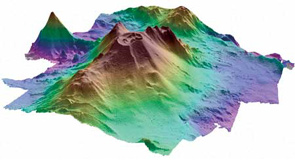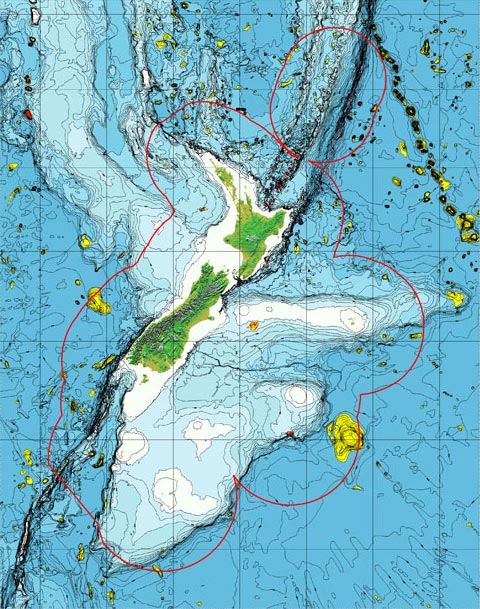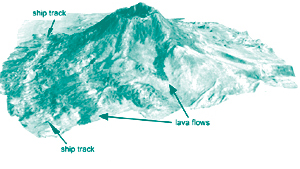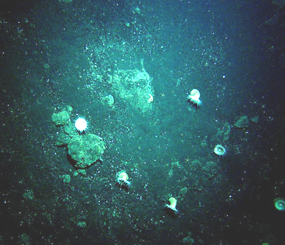
Scientists call for 'national parks' of the oceans
"Scientists have identified "rainforests" under the oceans - including in Australian waters - where biological diversity is at its greatest..."
7 August 2003
New Zealand Herald
UN help sought for corals hidden in cold seas
"The United Nations should help to protect little-known corals in deep, cold waters along with tropical cousins such as Australia's Great Barrier Reef, Norway's Environment Minister said..."
13 June 2003
New Zealand Herald
Trawlers blamed for plight of underwater 'rainforest'
"Scientists have raised the alarm about fishing trawlers that are destroying deepwater coral around New Zealand..."
2 June 2003
New Zealand Herald
Deep sea life also needs protection
"When fishermen in the Ross Sea hauled up in April the second-ever intact specimen of what is being termed the "colossal squid", the world wanted to know more..."
2 June 2003
New Zealand Herald
|
 |
|

Seamounts - discovery of a new ocean world
10 May 2004
Deepsea biodiversity has become one of the most important environmental issues in the world today. Long neglected because it was remote, inaccessible and unknown, the deep ocean has become a new ecological frontier that is swiftly gaining attention.
There are about 870 topographical seafloor features called seamounts in New Zealand's ocean territory. Their geologic origin is volcanic and many are active hydrothermal vents, reflecting the extensive volcanic history of the country. Some seamounts are comparable in size with terrestrial mountains, and their ecosystems are unlike anything else. |
 |
A terrain model of the Brothers seamount on the southern Kermadec Ridge, northeast of the New Zealand mainland.
|
| |
| |
| |
|
A National Institute of Water and Atmospheric Research (NIWA) mapping expedition in 2002, along the southern Kermadec Ridge which runs from White Island in the Bay of Plenty to the Kermadec Islands, produced remarkable images of 50 new seamounts.
Six of the southern Kermadec seamounts are about 2,500 metres (8,260 feet) in height, which is as tall as Mt Taranaki, New Zealand's second highest volcanic terrestrial mountain. One of them rises to 65 metres below the surface of the ocean, while other peaks are 1,500 metres beneath the surface. The largest is 20 km in diameter, and 13 are 10 km in diameter. |
| |
 |
showing locations of the Rumble and Brothers seamounts.
New Zealand is the world's fourth largest maritime nation, with responsibility for the management of 483 million hectares of ocean. |
| |
The chain of prominent seamounts known as Rumble I, II, III, IV and V, and Brothers cover
a 160 kilometre stretch of the southern Kermadec Ridge. The most southerly of the group, Rumble IV, is 150 km due north from the New Zealand mainland at Cape Runaway, and 230 km due east of Great Barrier Island.
 See map See map
Rumble III reaches up to 140 metres below the surface, and is the most active of the southern Kermadec volcanoes, with hydrophonically detected eruptions in 1958, 1965, 1970 and 1973. In 1986, steam was seen rising from the ocean with a 500 square metre sulphur slick, and then discoloured water caused by a rising gas plume was observed. There was activity again in 1992 when gas bubbles were acoustically detected. |

Terrain model of the Haungaroa seamount.
|
| |
| |
| |
|


Deepsea discoveries during the last ten years are as exciting as the discovery of terrestrial New Zealand by Captain James Cook more than two centuries ago. Just as Cook made startling finds on land, hundreds of new species in the deepsea have been identified, thousands more are expected, and endemic ecosystems have become apparent.
Unlike Cook's discovery of a pristine coastal environment, damage in the deepsea by bottom trawl fishing is noticeable, before the newly found ecosystems can be described.
Orange roughy fish live around seamounts and plateaus just off the continental shelf at depths of 500-1500m. |
 |
See more on deep-sea fisheries
 Rough seas for orange roughy
Rough seas for orange roughy
 Scientists call for deep-sea coral protection
Scientists call for deep-sea coral protection
Only a few large mussels occur worldwide on hydrothermal vents. Two new
Bathymodiolus species which grow up to 20cm long were identified in 2001 in
New Zealand waters for the first time. |
 |
The large mussel shown left is 15 cm long, found on the active volcanic Rumble III seamount on the southern Kermadec Ridge.
Photo courtesy NIWA. |
|
New Zealand seamounts and above-water archipelagos are regarded as the highest productive area of the southwest Pacific, and a center of global ecosystem production.
Active volcanic seamount vents discharge manganese and iron, which is carried by seafloor currents, and is thought to provide nutrients for microscopic organisms on which ocean food chains and fisheries are based. Readings over some seamounts show manganese and iron discharge at 10 times ordinary levels.
Hydrothermal vents have extreme conditions that seem inhospitable to living organisms, where nevertheless, life can flourish. Living things are exposed to high hydrostatic pressure, without light, in water enriched with toxic compounds such as hydrogen sulphide, and radionucleids.
Temperatures around vents can reach 400 degrees Celsius. In spite of the harsh environment, vents can be colonized by a very luxuriant and productive fauna based on bacterial chemosynthesis that appears to be well adapted to living in the severe conditions.
During a month long research voyage to the Norfolk Ridge and Lord Howe Rise in 2003, more than 400 new species of fish and other animals were discovered. The voyage collected samples of 500 fish species and 1,100 invertebrate species, including new finds of jelly-like sea cucumbers, fish resembling blobs of mucous, several species of blue rays, crabs, starfish, sea anemones, and a new potentially commercial species of redfish.
|
 |
|




